Click on images to enlarge

habit (Photo: Bruce Maslin)
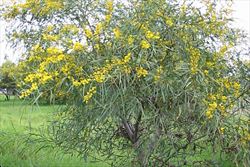
habit in flower (Photo: Sheldon Navie)

habit in flower (Photo: Sheldon Navie)

rough bark of mature tree (Photo: Bruce Maslin)
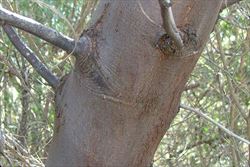
smooth bark of younger tree (Photo: Sheldon Navie)

globular flower clusters (Photo: Sheldon Navie)
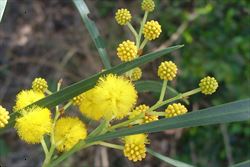
close-up of flower buds and globular flower clusters (Photo: Sheldon Navie)
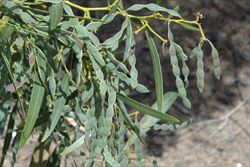
immature fruit (Photo: Rob and Fiona Richardson)
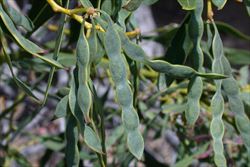
close-up of immature fruit (Photo: Rob and Fiona Richardson)
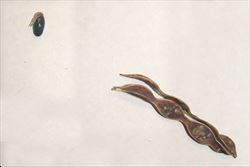
mature fruit and seed with small fleshy aril (Photo: Sheldon Navie)
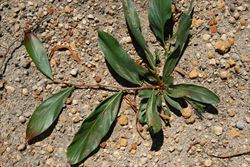
seedling with broader phyllodes and some remnant twice-compound leaves (Photo: Bruce Maslin)

root suckers (Photo: Bruce Maslin)

drooping 'leaves' (Photo: Bruce Maslin)

elongated 'leaves' showing prominent central vein (Photo: Sheldon Navie)

close-up of 'leaf' bases showing glands (Photo: Sheldon Navie)

close-up of seeds with small fleshy arils (Photo: Tracey Slotta at USDA PLANTS Database)
Scientific Name
Acacia saligna (Labill.) H.L. Wendl.
Synonyms
Acacia bracteata Maiden & BlakelyAcacia cyanophylla Lindl.Acacia lindleyi Meisn.Mimosa saligna Labill.Racosperma salignum (Labill.) Pedley
Family
Fabaceae: sub-family Mimosoideae (New South Wales)Leguminosae (South Australia)Mimosaceae (Queensland, the ACT, Victoria, Tasmania, Western Australia and the Northern Territory)
Common Names
blue leaf wattle, blue leaved wattle, blue-leaf wattle, blue-leafed wattle, blue-leaved wattle, coojong, golden willow wattle, golden wreath wattle, golden-wreath wattle, orange wattle, Port Jackson wattle, Port Jackson willow, weeping wattle, Western Australian golden wattle, western wattle, willow wattle
Origin
Native to south-western Western Australia, where it is widespread and often quite common. Its natural distribution extends mainly from Wilgiamia Pool, north-east of Kalbarri, south-eastwards to Ponier Rock, about 65 km south of Balladonia. A few outlying populations also occur further north on Kalbarri on Meka, Murgoo and Jingemarra Stations.
Cultivation
Golden wreath wattle (Acacia saligna) is a fast growing, drought tolerant, species that is widely cultivated in Australia. It is has been extensively grown in roadside and amenity plantings and as a garden ornamental. It has also been used for sand dune stabilisation, particularly following sand mining, and in other revegetation activities. Though four slightly different forms of this species have been in identified the wild in Western Australia, there are only two main forms in cultivation in Australia. One form is upright and slender with an umbrella-like crown, while the other form is dense and low-growing with pendulous branches drooping to near the ground.
Naturalised Distribution
Naturalised in parts of South Australia, Victoria, Tasmania, New South Wales and Queensland. In South Australia it is naturalised in the south-eastern parts of the state (including the Yorke Peninsula, with the most extensive infestations being around Minlaton and Stansbury), on the Eyre Peninsula and on Kangaroo Island. In Victoria it is widely naturalised in the western and central parts of the state. In New South Wales it is widely naturalised in coastal districts and also in southern inland areas of the state. It is also naturalised in the coastal districts of south-eastern Queensland. There are also unconfirmed reports that it is naturalised in Tasmania.
Golden wreath wattle (Acacia saligna ) is also naturalised beyond its native range in Western Australia, where it is often found along disturbed roadsides. However, it is sometimes difficult to determine if these populations represent natural occurrences or are the result of escapes from roadside revegetation programs.
Also widely naturalised overseas in Africa (i.e. South Africa, Zambia, Namibia, Tanzania, Uganda, Mozambique, Ethiopia, Kenya and Libya), the Middle East (i.e. Israel, Jordan, Saudi Arabia, Yemen and Iraq), Asia (i.e. India and Pakistan), Europe (i.e. Spain, Portugal, France, Corsica, Sardinia, Sicily, Italy and Greece), South America (Argentina, Bolivia and Chile), Mauritius, on the North Island of New Zealand, and in south-western USA (i.e. California).
Habitat
In Western Australia this species grows naturally in a variety of habitats, but in drier inland areas it is generally restricted to areas near watercourses. It is most commonly found growing in sandy soils, but is also present in clayey soils and around granite outcrops or on rocky hills.
Where it has become naturalised it occurs in coastal shrublands, open woodlands, grassy woodlands, heathlands, moist closed forests and near watercourses (i.e. riparian areas). However, it is primarily found in disturbed habitats.
Habit
An upright (i.e. erect) and spreading shrub or small tree usually growing 2-6 m tall, but occasionally reaching up to 10 m in height. This species is relatively short-lived with a life-span of only 10-20 years, except in drier locations where it may persist for longer periods.
Distinguishing Features
- a shrub or small tree with simple 'leaves' that are green or bluish-green in colour.
- its younger branches and 'leaves' are drooping in nature.
- its relatively narrow 'leaves' (usually 7-30 cm long and 2-20 mm wide) are either straight or sickle-shaped.
- its golden-yellow flowers borne in small globular clusters (7-12 mm across) that are arranged into larger elongated compound clusters.
- its elongated and somewhat flattened pods (50-140 mm long and only 4-6 mm wide) are slightly constricted between each of the seeds.
Stems and Leaves
The bark of mature trees is usually smooth or finely fissured (sometimes rough and furrowed) and grey or brownish-grey in colour. Mature trunks can be up to 40 cm across and may be either straight or rather crooked. Younger branches are either rounded, angled or somewhat flattened and often drooping (i.e. pendulous) in nature. These branches are smooth and hairless (i.e. glabrous), green or reddish-green in colour, and usually slightly zig-zagged (i.e. flexuose) in nature. They are often covered in a whitish powdery substance (i.e. pruinose), which is especially apparent when they are young.
The 'leaves' of this plant are actually flattened and widened leaf stalks (i.e. petioles), and not leaves in the true sense of the word. These modified leaf stalks are called phyllodes, but serve the same function as a regular leaf. On very young plants, partially formed phyllodes can be seen which bear twice-compound (i.e. bipinnate) leaves at their tips. As the seedling grows, each new 'leaf' has phyllodes that are more fully formed and the leaves at their tips become reduced and eventually vanish altogether. The phyllodes are usually alternately arranged along the stems (occasionally quite clustered) and often held in a drooping position (i.e. pendulous). They are quite variable in shape and size (usually 7-30 cm long and 2-20 mm wide), range from somewhat elongated to very elongated in shape (i.e. linear to lanceolate), and are straight to sickle-shaped (i.e. falcate) in nature. However, the phyllodes of younger plants are often somewhat broader (up to 60 mm wide) and often have wavy margins. The phyllodes are usually more than ten times longer than they are wide, are dull green to bluish-green (i.e. glaucous) in colour, and have pointed or somewhat pointed tips (i.e. acute, sub-acute or mucronate apices). They are hairless (i.e. glabrous) and have a prominent vein running lengthwise down their centre (i.e. a midrib). Phyllodes may be either thin and flexible or thick and somewhat leathery, or even slightly fleshy in nature. At the base of each of the phyllodes there is a very short wrinkled structure (1-2 mm long) that resembles a leaf stalk (i.e. pulvinus). On the upper margin of the phyllode there is a small disc-shaped structure (i.e. gland) 1-2 mm wide which is located just 0-10 mm above the base of the phyllode.
Flowers and Fruit
The small bright yellow or golden-yellow (or even orange-yellow) flowers are fluffy in appearance due to the presence of numerous stamens. They have five relatively inconspicuous petals and sepals and are densely arranged into small globular clusters (7-12 mm across). The small globular flower clusters usually contain 25-55 flowers and are borne on hairless stalks (i.e. glabrous peduncles) 4-15 mm long. These flower clusters are alternately arranged along a hairless flowering branch (2-50 mm long) that emanates from the forks (i.e. axils) of the upper leaves. They form larger elongated compound clusters containing 2-12 of the small globular flower clusters (i.e. they form racemes). Flowering occurs during late winter and spring (i.e. from July to November).
The fruit is a narrow and very elongated pod (50-140 mm long and 4-6 mm wide) that is hairless (i.e. glabrous) and somewhat flattened. These pods vary from being straight to strongly curved, and are slightly constricted between each of the seeds. They are green in colour when young and sometimes sparsely covered in a white powdery substance (i.e. pruinose), but turn light brown or brown in colour as they mature. The pods, which are usually present in late spring and summer (i.e. from November to January), also have hardened paler-coloured margins and contain 4-10 seeds. The seeds are dark brown or black in colour, oblong or oval (i.e. elliptic) in shape and have a shiny appearance. These seeds (5-6 mm long and 3-3.5 mm wide) also have a yellowish, fleshy, club-shaped structure (i.e. clavate aril) attached to them.
Reproduction and Dispersal
This species reproduces by seed and also vegetatively by root suckers. The long-lived seeds can remain dormant in the soil for more than a decade. Golden wreath wattle (Acacia saligna) will also readily re-shoot (i.e. coppice) after being lopped above ground level or otherwise damaged (e.g. by fire).
The seeds are dispersed by ants and birds, which are attracted by the fleshy arils that are attached to the seeds. Many infestations in New South Wales and Victoria are known to have established from seed dispersed in soil and gravel used for road construction activities. Seeds are also known to be spread on machinery, by roadside slashing, and in dumped garden waste. They can also be dispersed short distances by wind and water.
Environmental Impact
Golden wreath wattle (Acacia saligna) is an important environmental weed in the south-eastern parts of Australia. While naturalised populations of this species are not yet very extensive, they are quite widespread and the impacts of this species in some locales are quite severe. It is currently regarded as a significant environmental weed in Victoria, New South Wales and South Australia, and also as a minor environmental weed in Queensland and those parts of Western Australia that are outside its native range.
This very adaptable and aggressive species tolerates relatively dry, low nutrient, soils and grows very vigorously in better conditions. Hence, golden wreath wattle (Acacia saligna) has often been included in revegetation and amenity plantings and was used in dune rehabilitation projects following sand mining activities. Where it has been used for dune stabilisation and rehabilitation it has spread and invaded coastal sand dunes and nearby bushland areas. Where it has been grown as a garden ornamental it has escaped into nearby open forests, particularly where disturbance has occurred, and where it has been grown in revegetation areas and in amenity plantings it has often spread along nearby highways and into surrounding bushland.
Disturbance around infestations of this species usually stimulates mass seed germination, and this is most apparent on road edges, particularly after fire. Dense stands of golden wreath wattle (Acacia saligna) will shade out many ground-growing native plants, crowd out shrubs, and may also impede overstorey regeneration. Like other wattles (Acacia spp.) it can fix nitrogen and increase soil fertility, which may affect the persistence of some indigenous species and promote the invasion of other weeds.
Golden wreath wattle (Acacia saligna) is weedy throughout the eastern and southern inland areas of New South Wales, but is particularly common in the coastal districts of the central and northern parts of the state. In the north-eastern part of the state it is included on the 'Bushland Friendly Nursery Scheme' (BFNS) list of environmental weeds, a list of the most significant environmental weeds for this part of New South Wales. It is also regarded as an important environmental weed in the coastal districts of central New South Wales and in the wider Sydney and Blue Mountains region, and appears on many environmental weed lists in this region of the state (e.g. the Warringah Council environmental weeds register, the environmental weed list for the Sydney North region, the Central Coast Community Environment Network environmental weed list, the Manly Council environmental weed list, the Blue Mountains City Council bushland weed list, and the Australian Association of Bush Regenerators (AABR) list of bushland weeds for the wider Sydney and Blue Mountains region). In one example of its potential weediness, it was inadvertently seeded in a rainforest revegetation project in the Wollongong area when it was wrongly distributed by a seed supplier. This led to hundreds of golden wreath wattle (Acacia saligna) plants vigorously growing amongst the native seeded species and a significant clean-up effort then had to be undertaken to systematically remove it from the site.
In Victoria it is a problem on coastal sand dunes and in open forests in many areas of the state, and appears on some local environmental weed lists in this state too. On the Mornington Peninsula, south of Melbourne, this species is considered to be one of the most difficult to control environmental weeds because it suckers as well as producing seeds. Within this area, golden wreath wattle (Acacia saligna) is one of several weed species that has been targeted for removal from Kananook Creek.
In South Australia it is also invading bushland, particularly in the Greater Adelaide Region and in the south-eastern corner of the state. It also appears on several local environmental weed lists in this state (i.e. the common environmental weeds of the Adelaide region list, the common coastal weeds in the Gulf St. Vincent area list, the bushland weeds in South Australia list, the weeds of Marino Conservation Park list and the Adelaide Hills Council bushland invasive plants list). In the Adelaide metropolitan area it is one of the priority weeds occurring in the coastal Semaphore South Dune Reserve. It is also one of ten native plants that are considered to be serious weeds in the Mount Lofty Ranges.
In Queensland it is currently less widespread, but has become a bushland and seashore weed in a few localities in the coastal parts of the Moreton district in the south-east of the state. In south-western Western Australia, golden wreath wattle (Acacia saligna ) has become naturalised in reasonably intact bushland in areas that are located outside its natural range.
Golden wreath wattle (Acacia saligna) is also one of the most serious environmental weeds in South Africa, where it is has been observed to dominate and transform entire vegetation communities. It invades and displaces indigenous vegetation in fynbos shrublands, woodlands and coastal sand dune communities. It also infests roadsides and watercourses, sometimes decreasing the water available for irrigation. However, the recent introduction of a biological control agent from Australia (i.e the rust fungus Uromycladium tepperianum) has been somewhat successful in controlling this species, reducing its population in some areas to 5-10% of its original density.
Legislation
This species is not declared or considered noxious by any state or territory government in Australia.
Management
For information on the management of this species see the following resources:
- the Golden Wreath Wattle page on the Sydney Weeds Committee website at http://www.sydneyweeds.org.au/.
- Muyt (2001), Bush Invaders of South-east Australia , pp. 159-160.
Similar Species
Golden wreath wattle (Acacia saligna) may be confused with several other species of native wattles (Acacia spp.) including golden wattle (Acacia pycnantha), straight wattle (Acacia stricta), sweet-scented wattle (Acacia suaveolens), manna wattle (Acacia microbotrya) and summer-scented wattle (Acacia rostellifera). These species can be distinguished by the following differences:
- golden wreath wattle (Acacia saligna) has branchlets and 'leaves' (i.e. phyllodes) that are often drooping in nature (i.e. pendulous). These phyllodes are straight to sickle-shaped (i.e. falcate), relatively large (7-25 cm long), but usually quite narrow (2-20 mm wide). Large numbers (25-55) of tiny bright yellow flowers are densely packed into globular clusters, several (2-10) of which are arranged along a short flowering branch (2-50 mm long). Its relatively large pods are long and narrow (50-140 mm long and 4-6 mm wide) and slightly constricted between each of the seeds.
- golden wattle (Acacia pycnantha) has branchlets and 'leaves' (i.e. phyllodes) that are drooping in nature (i.e. pendulous). These phyllodes are sickle-shaped (i.e. falcate), relatively large (6-20 cm long), and sometimes quite broad (5-50 mm wide). Very large numbers (40-100) of tiny bright yellow flowers are densely packed into globular clusters, many (4-23) of which are arranged on a relatively long flowering branch (20-150 mm long). Its relatively large pods are long and narrow (50-140 mm long and 5-8 mm wide) and sometimes slightly constricted between each of the seeds.
- straight wattle (Acacia stricta) has branchlets and 'leaves' (i.e. phyllodes) that are usually spreading or upright in nature (i.e. not pendulous). These phyllodes are relatively straight, moderately large (3-14 cm long), but quite narrow (3-15 mm wide). Large numbers (20-38) of tiny cream to golden yellow flowers are densely packed into globular clusters, a few (2-4) of which are borne in the 'leaf' forks (i.e. in the upper leaf axils). Its moderately large pods are long and very narrow (40 -100 mm long and 2-5 mm wide) and sometimes slightly constricted between each of the seeds.
- sweet-scented wattle (Acacia suaveolens) has branchlets and 'leaves' (i.e. phyllodes) that are usually spreading or upright in nature (i.e. not pendulous). These phyllodes are relatively straight, moderately large (7-12 cm long), but quite narrow (3-8 mm wide). Large numbers (20-38) of tiny cream to pale yellow flowers are densely packed into globular clusters, several (6-12) of which are arranged along a short flowering branch (10-25 mm long). Its relatively small pods are short and relatively broad (20-50 mm long and 10-20 mm wide) and usually not constricted between each of the seeds.
- manna wattle (Acacia microbotrya) has branchlets and 'leaves' (i.e. phyllodes) that are either spreading or drooping (i.e. pendulous) in nature. These phyllodes are somewhat sickle-shaped (i.e. falcate), moderately large (5-14 cm long), but quite narrow (5-20 mm wide). Relatively small numbers (20-30) of tiny cream to pale yellow flowers are densely packed into globular clusters, several of which are arranged along a short flowering branch (15-40 mm long). Its relatively large pods are long and narrow (up to 200 mm long and 6-8 mm wide) and strongly constricted between each of the seeds (i.e. moniliform).
- summer-scented wattle (Acacia rostellifera) has branchlets and 'leaves' (i.e. phyllodes) that are usually spreading in nature (i.e. not pendulous). These phyllodes are relatively straight, moderately large (4-12 cm long), but quite narrow (3-17 mm wide). Relatively small numbers (15-25) of tiny bright yellow flowers are densely packed into globular clusters, several (3-9) of which are arranged along a short flowering branch (10-30 mm long). Its moderately large pods are long and narrow (up to 90 mm long and 5-7 mm wide) and strongly constricted between each of the seeds (i.e. sub-moniliform).
Note: This page only covers those species that have been reported to be commonly confused with golden wreath wattle (Acacia saligna). For a more in-depth key to all of the wattles (Acacia spp.) present in Australia, see the Wattle: Acacias of Australia CD-ROM or Flora of Australia, Volumes 11A and 11B.

